Compact 15 mJ Fiber–Solid Hybrid Hundred-Picosecond Laser Source for Laser Ablation on Copper
Abstract
:1. Introduction
2. Experimental Setup
2.1. All-Fiber Master Oscillator
2.2. Nd:YAG Regenerative Amplifier
2.3. Nd:YAG Double-Pass Amplifier
3. Experimental Results and Discussion
3.1. The Spectral Characteristics of Yb-Doped Fiber Master Oscillator
3.2. Compensation for Self-Focusing and Thermally Induced Birefringence Effect
3.3. The Output Characteristics of Fiber–Solid Hybrid Laser Source
3.4. The Theoretical Simulation of Hundred-Picosecond Laser Ablation
4. Conclusions
Author Contributions
Funding
Institutional Review Board Statement
Informed Consent Statement
Data Availability Statement
Acknowledgments
Conflicts of Interest
References
- Bai, Z.X.; Wang, Y.L.; Lu, Z.W.; Jiang, L.; Yuan, H.; Liu, Z.H. Demonstration of an ultraviolet stimulated Brillouin scattering pulse compressed hundred picosecond laser in LiB3O5 crystals. J. Opt. 2017, 19, 085502. [Google Scholar] [CrossRef]
- Chen, H.; Deng, L.M.; Duan, J.; Zeng, X.Y. Picosecond laser welding of glasses with a large gap by a rapid oscillating scan. Opt. Lett. 2019, 44, 2570–2573. [Google Scholar] [CrossRef] [PubMed]
- Ly, S.; Shen, N.; Negres, R.A.; Carr, C.W.; Alessi, D.A.; Bude, J.D.; Rigatti, A.; Laurence, T.A. The role of defects in laser-induced modifications of silica coatings and fused silica using picosecond pulses at 1053 nm: I. Damage morphology. Opt. Express 2017, 25, 15161–15178. [Google Scholar] [CrossRef] [PubMed]
- Žemaitis, A.; Gaidys, M.; Brikas, M.; Gečys, P.; Račiukaitis, G.; Gedvilas, M. Advanced laser scanning for highly-efficient ablation and ultrafast surface structuring: Experiment and model. Sci. Rep. 2018, 8, 17376. [Google Scholar] [CrossRef]
- Hou, Z.Y.; Liu, L.J.; Fang, Z.; Yang, L.; Ya, D.X.; Wang, X.Y.; Xu, D.G.; Chen, C.T. High-power 266 nm laser generation with a NaSr3Be3B3O9F4 crystal. Opt. Lett. 2018, 43, 5599–5602. [Google Scholar] [CrossRef]
- Galletti, M.; Oliveira, P.; Galimberti, M.; Ahmad, M.; Archipovaite, G.; Booth, N.; Dilworth, E.; Frackiewicz, A.; Winstone, T.; Musgrave, I. Ultra-broadband all-OPCPA petawatt facility fully based on LBO. High Power Laser Sci. Eng. 2020, 8, e31. [Google Scholar] [CrossRef]
- Long, M.L.; Zhang, Z.P.; Chen, Z.E.; Zhang, H.F.; Deng, H.R.; Wu, Z.B.; Meng, W.D. A picosecond laser at 1 kHz with dual-length of regenerative amplifier for the SLR in the daytime. Optik 2018, 171, 833–838. [Google Scholar] [CrossRef]
- Zhang, Z.P.; Zhang, H.F.; Long, M.L.; Deng, H.R.; Wu, Z.B.; Meng, W.D. High precision space debris laser ranging with 4.2 W double-pulse picosecond laser at 1 kHz in 532 nm. Optik 2019, 179, 691–699. [Google Scholar] [CrossRef]
- Wang, K.X.; Li, P.X.; Yu, X.Y.; Yao, C.F.; Wang, T.T. Experimental study on CMOS and materials irradiated by hundred-picosecond pulse laser with high repetition rate. Proc. SPIE 2020, 1154407, 15–23. [Google Scholar]
- Liu, X.S.; Jia, W.Z.; Yang, S.; He, H.; Liu, Y.Q.; Yan, A.R.; Wang, Z.Y. A high pulse energy single-pass picosecond master oscillator power amplifier system with output power 35.7 W. Opt. Laser Technol. 2020, 121, 105782. [Google Scholar] [CrossRef]
- Liu, X.S.; Jia, W.Z.; Song, Y.H.; Yang, S.; Liu, S.; Liu, Y.Q.; Yan, A.R.; Wang, Z.Y. High energy, high brightness picosecond master oscillator power amplifier with output power 65.5 W. Opt. Express 2020, 28, 8016–8026. [Google Scholar] [CrossRef] [PubMed]
- Ma, N.; Chen, M.; Yang, C.; Lu, S.; Zhang, X.; Du, X.B. High-efficiency 50W burst-mode hundred picosecond green laser. High Power Laser Sci. Eng. 2020, 8, e1. [Google Scholar] [CrossRef]
- Zhou, Y.P.; Li, X.D.; Wu, W.T.; Jiang, Y.G.; Fan, R.W.; Chen, D.Y.; Yan, R.P. 500 Hz, 47.1 mJ, sub-nanosecond MOPA laser system. Opt. Laser Technol. 2021, 134, 106592. [Google Scholar] [CrossRef]
- Noom, D.W.E.; Witte, S.; Morgenweg, J.; Altmann, R.K.; Eikema, K.S.E. High-energy, high- repetition-rate picosecond pulses from a quasi-CW diode-pumped Nd:YAG system. Opt. Lett. 2013, 38, 3021–3023. [Google Scholar] [CrossRef]
- Huang, Y.T.; Zhang, H.B.; Yan, X.C.; Guo, G.Y.; Bai, Z.N.; Lin, W.R.; Kang, Z.J.; Qiu, J.S.; Zhao, T.Z.; Fan, Z.W. High-Brightness 100 Hz/363 mJ Picosecond Nd:YAG Laser System for Ultra-Remote Laser Ranging. IEEE J. Quantum Electron. 2020, 56, 1700310. [Google Scholar] [CrossRef]
- Huang, L.; Ma, P.F.; Tao, R.M.; Shi, C.; Wang, X.L.; Zhou, P. 11.5 kW ytterbium-doped single- transverse-mode linearly polarized monolithic fiber master oscillator power amplifier. Appl. Opt. 2015, 54, 2880–2884. [Google Scholar] [CrossRef]
- Yu, Z.H.; Shi, W.; Dong, X.Z.; Li, J.H.; Zhao, Y.Z.; Liu, H.X. 110 W all-fiber picosecond master oscillator power amplifier based on large-core-diameter ytterbium-doped fiber. Appl. Opt. 2016, 55, 4119–4122. [Google Scholar] [CrossRef]
- Saraceno, C.J.; Sutter, D.; Metzger, T.; Ahmed, M.A. The amazing progress of high-power ultrafast thin-disk lasers. J. Eur. Opt. Soc.-Rapid Publ. 2019, 15, 15. [Google Scholar] [CrossRef]
- Smrz, M.; Muzik, J.; Stepankova, D.; Turcicova, H.; Novak, O.; Chyla, M.; Hauschwitz, P.; Brajer, J.; Kubat, J.; Todorov, F.; et al. Picosecond thin-disk laser platform PERLA for multi-beam micromachining. OSA Contin. 2021, 4, 940–952. [Google Scholar] [CrossRef]
- Dong, X.Y.; Li, P.X.; Li, S.; Wang, T.T.; Yang, M. High Beam Quality Fiber-Solid Hybrid Innoslab Picosecond Amplifier with High Repetition Rate. Chin. J. Lasers 2021, 48, 1701004. [Google Scholar]
- Shi, B.N.; Li, J.T.; Ye, S.; Nie, H.K.; Yang, K.J.; He, J.L.; Li, T.; Zhang, B.T. Modified Frantz-Nodvik equation and numerical simulation of a high-power Innoslab picosecond laser amplifier. Opt. Express 2022, 30, 11026–11035. [Google Scholar] [CrossRef] [PubMed]
- Dong, X.Y.; Li, P.X.; Li, S.; Wang, D.S. High gain fiber-solid hybrid double-passing end-pumped Nd:YVO4 picosecond amplifier with high beam quality. Chin. Phys. B 2020, 29, 054207. [Google Scholar] [CrossRef]
- Liu, M.Z.; Liu, M.L.; Yan, W.; Yang, D.W.; Wang, L.S.; Sun, S.S.; Jia, Z.Q.; Zhai, R.Z.; Wang, Y.; Zhao, K. Fiber-solid hybrid end-pumped Nd:YVO4 picosecond amplifier with high beam quality. Laser Phys. 2021, 31, 065801. [Google Scholar] [CrossRef]
- Lv, X.L.; Su, H.P.; Peng, Y.J.; Leng, Y.X. High-energy, quasi-CW 355 nm UV pulses generation from a diode pumped sub-nanosecond Nd:YAG system. Proc. SPIE 2018, 10896, AM6A-20. [Google Scholar]
- Honig, J.; Halpin, J.; Browning, D.; Crane, J.; Hackel, R.; Henesian, M.; Peterson, J.; Ravizza, D.; Wennberg, T.; Rieger, H.; et al. Diode-pumped Nd:YAG laser with 38 W average power and user-selectable, flat-in-time subnanosecond pulses. Appl. Opt. 2007, 46, 3269–3275. [Google Scholar] [CrossRef]
- Wang, C.; Wei, H.; Wang, J.F.; Jiang, Y.E.; Fan, W.; Li, X.C. Laser diode pumped Nd:YAG laser with high repetition and high average power. Acta Phys. Sin. 2014, 63, 224204. [Google Scholar] [CrossRef]
- Lv, X.L.; Peng, Y.J.; Wang, W.Y.; Zhao, Y.A.; Zhu, X.Y.; Leng, Y.X. High-energy, high-repetition-rate ultraviolet pulses from an efficiency-enhanced, frequency-tripled laser. High Power Laser Sci. Eng. 2021, 9, e38. [Google Scholar]
- Michailovas, K.; Baltuska, A.; Pugzlys, A.; Smilgevicius, V.; Michailovas, A.; Zaukevicius, A.; Danilevicius, R.; Frankinas, S.; Rusteika, N. Combined Yb/Nd driver for optical parametric chirped pulse amplifiers. Opt. Express 2016, 24, 22261–22271. [Google Scholar] [CrossRef]
- Lian, F.Q.; Fan, Z.W.; Bai, Z.A.; Li, X.H.; Wang, Q.J. Optimization of spectral distortion in a ytterbium-doped mode-locked fiber laser system. Photon. Res. 2015, 3, 129–132. [Google Scholar] [CrossRef]
- Yang, M.; Li, P.X.; Li, S.; Xiong, W.H.; Wang, K.X.; Yao, C.F.; Wang, D.S. 54 W nanosecond Yb-doped all-fiber amplifier at ultra-high repetition rate (tens of MHz) based on mode-locked fiber oscillator and single-mode fiber stretcher. Laser Phys. 2021, 31, 025101. [Google Scholar] [CrossRef]
- Agrawal, G.P. Nonlinear Fiber Optics, 5th ed.; Beijing World Publishing Corporation: Beijing, China, 2015. [Google Scholar]
- Sizova, I.; Moskalev, T.; Mikheev, L. Laser beam shaping with circular serrated apertures. I. Spatial filtering. Appl. Opt. 2019, 58, 4905–4909. [Google Scholar] [CrossRef] [PubMed]
- Sizova, I.; Moskalev, T.; Mikheev, L. Laser beam shaping with circular serrated apertures. II. Theory of the beam profile formation. Appl. Opt. 2019, 58, 4910–4917. [Google Scholar] [CrossRef]
- Wu, C.C.; Gao, F.H.; Huang, D.Q.; Yang, Z.J.; Guo, Y.K.; Du, J.L.; Zhang, Y.X. Design and fabrication of a slot aperture with softened edge based on gray-tone coding method. Microelectron. Eng. 2011, 88, 2180–2183. [Google Scholar] [CrossRef]
- Ostermeyer, M.; Klemz, G.; Kubina, P.; Menzel, R. Quasi-continuous-wave birefringence- compensated single- and double-rod Nd:YAG lasers. Appl. Opt. 2002, 41, 7573–7582. [Google Scholar] [CrossRef]
- Jeong, J.; Cho, S.; Kim, T.; Yu, T.J. Numerical Study of a Thermally-compensated High-energy Double-pass Nd:YAG Amplifier Design. J. Korean Phys. Soc. 2016, 68, 653–657. [Google Scholar] [CrossRef]
- Yang, C.; Peng, H.P.; Chen, M.; Lu, S.; Ma, N. Effect of the azimuthal gradient of the thermal load on the depolarization of cylindrical vector beams propagating in a side non-uniformly pumped isotropic medium. Results Phys. 2019, 12, 2069–2074. [Google Scholar] [CrossRef]
- Yang, S.S.; Cui, Z.J.; Sun, Z.M.; Zhang, P.; Liu, D. Compact 50 W All-Solid-State Picosecond Laser System at 1 kHz. Appl. Sci. 2020, 10, 6891. [Google Scholar] [CrossRef]
- Ren, Y.P.; Chen, J.K.; Zhang, Y.W. Optical properties and thermal response of copper films induced by ultrashort-pulsed lasers. J. Appl. Phys. 2011, 110, 113102. [Google Scholar] [CrossRef]
- Ji, L.P.; Song, Z.Y.; Sun, Y.P.; Wang, X.S.; Li, C.Y. Single-short picosecond laser ablation of copper based on Comsol. Laser Optoelectron. Prog. 2018, 55, 101402. [Google Scholar]
- Jia, X.; Zhao, X. Numerical study of material decomposition in ultrafast laser interaction with metals. Appl. Surf. Sci. 2019, 463, 781–790. [Google Scholar] [CrossRef]
- Shin, J.; Mazumder, J. Plasma diagnostics using optical emission spectroscopy in laser drilling process. J. Laser Appl. 2016, 28, 022008. [Google Scholar] [CrossRef]
- Wang, T.T.; Li, P.X.; Yu, X.Y.; Wang, K.X.; Wang, D.S.; Zhang, Y.F.; Li, C.Y. High-energy hundred-picosecond fiber-solid hybrid laser and its application in laser-induced damage in PIN photodiode. Laser Phys. 2020, 30, 036004. [Google Scholar] [CrossRef]
- Wang, K.X.; Yu, X.Y.; Li, P.X.; Wang, T.T.; Zhang, Y.F.; Li, C.Y. Laser-induced damage in a silicon-based photodiode by MHz picosecond laser. Laser Phys. 2020, 30, 076002. [Google Scholar] [CrossRef]
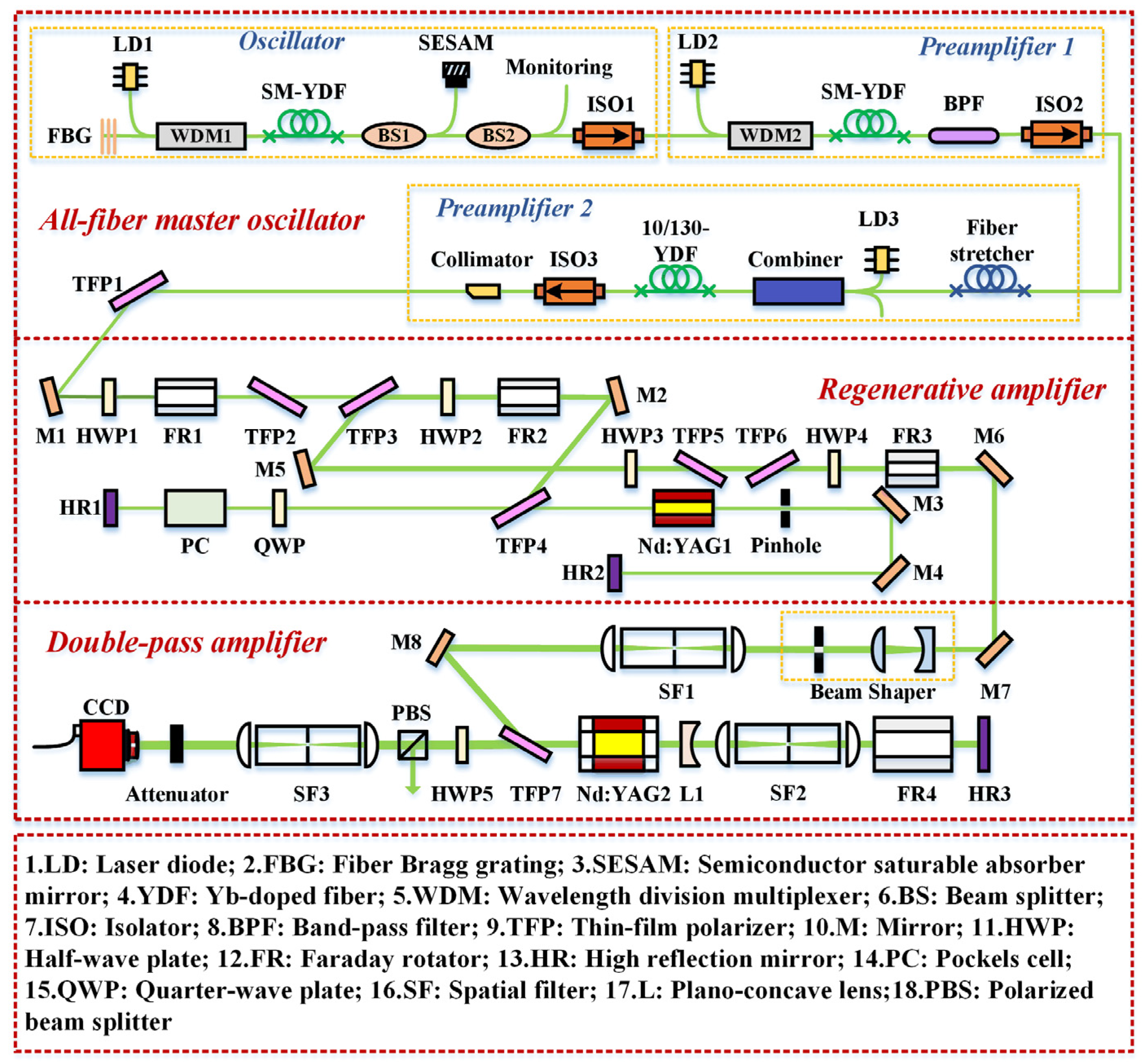



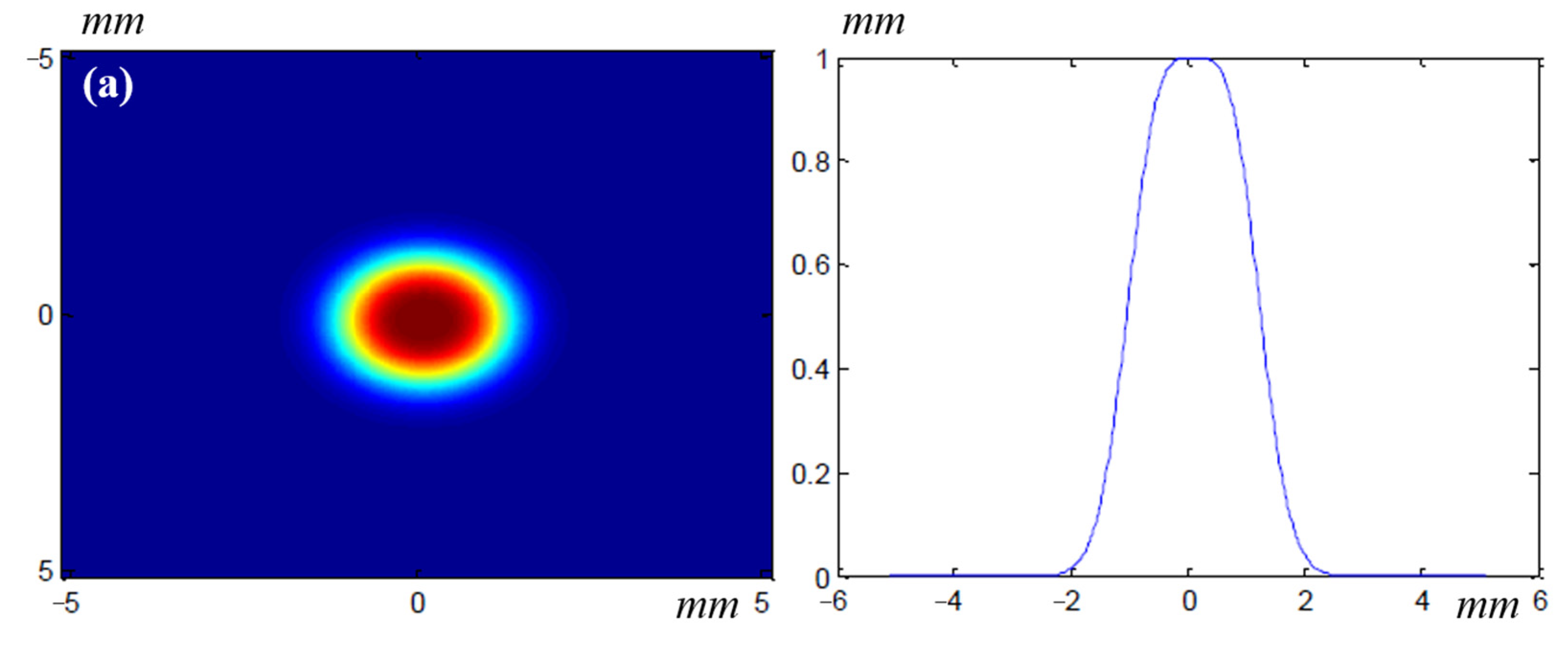
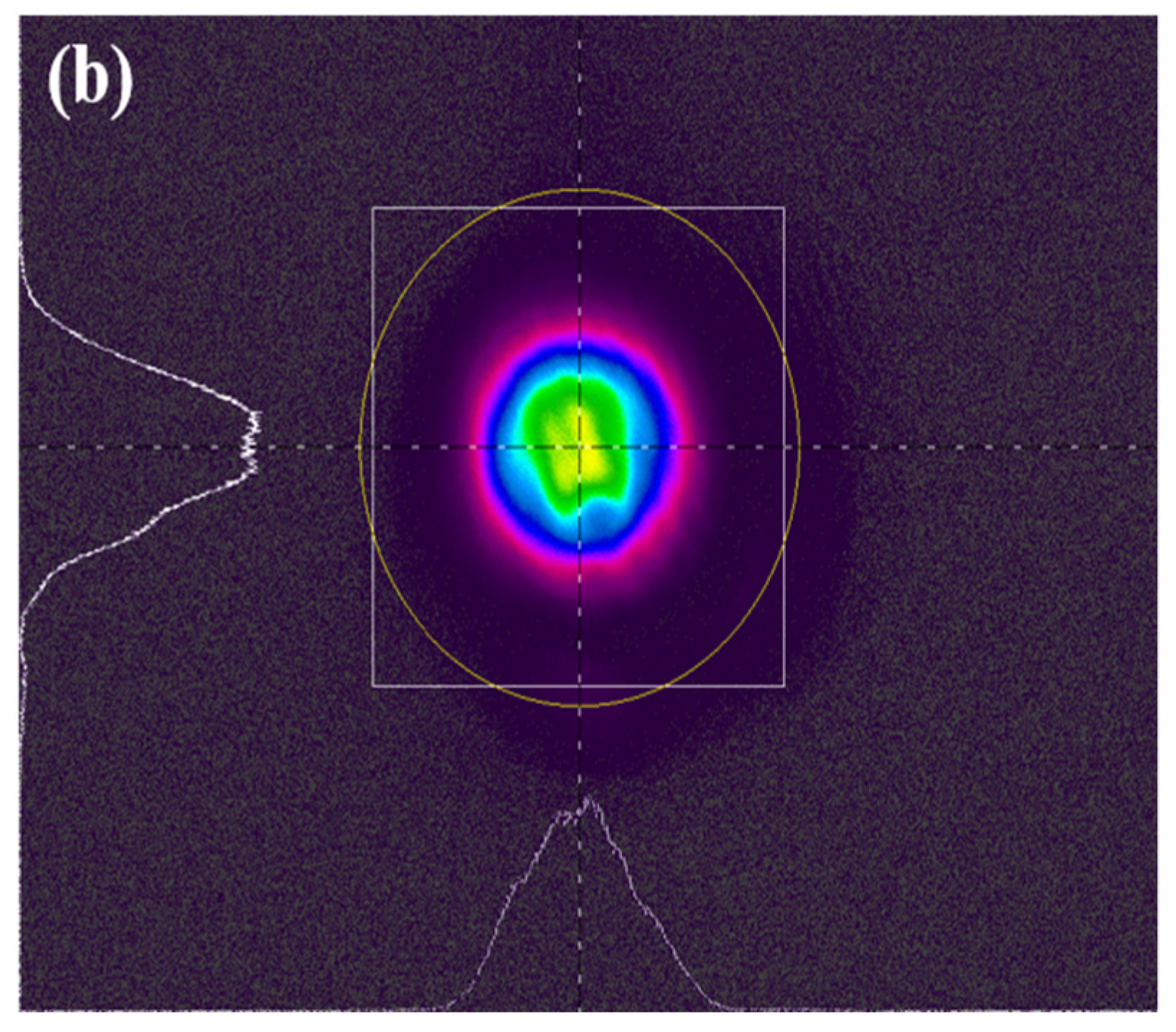
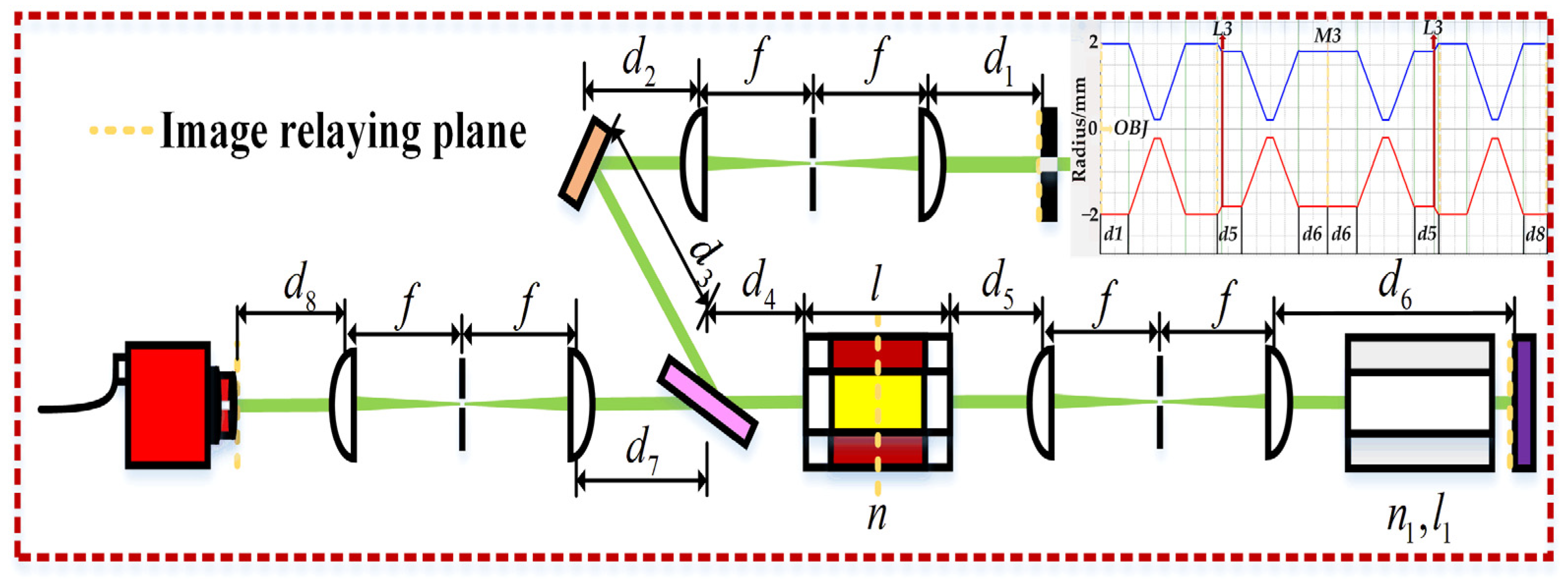


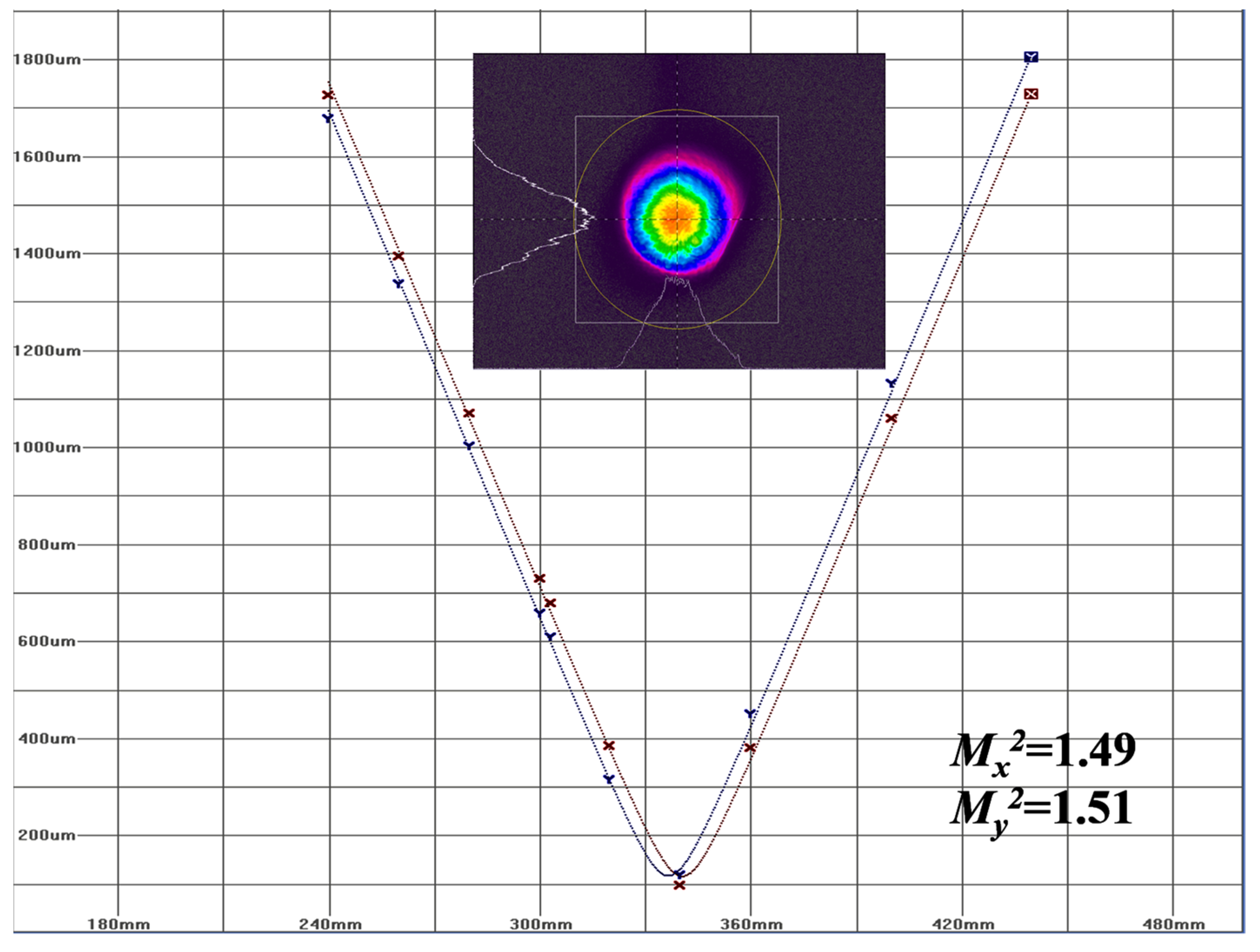

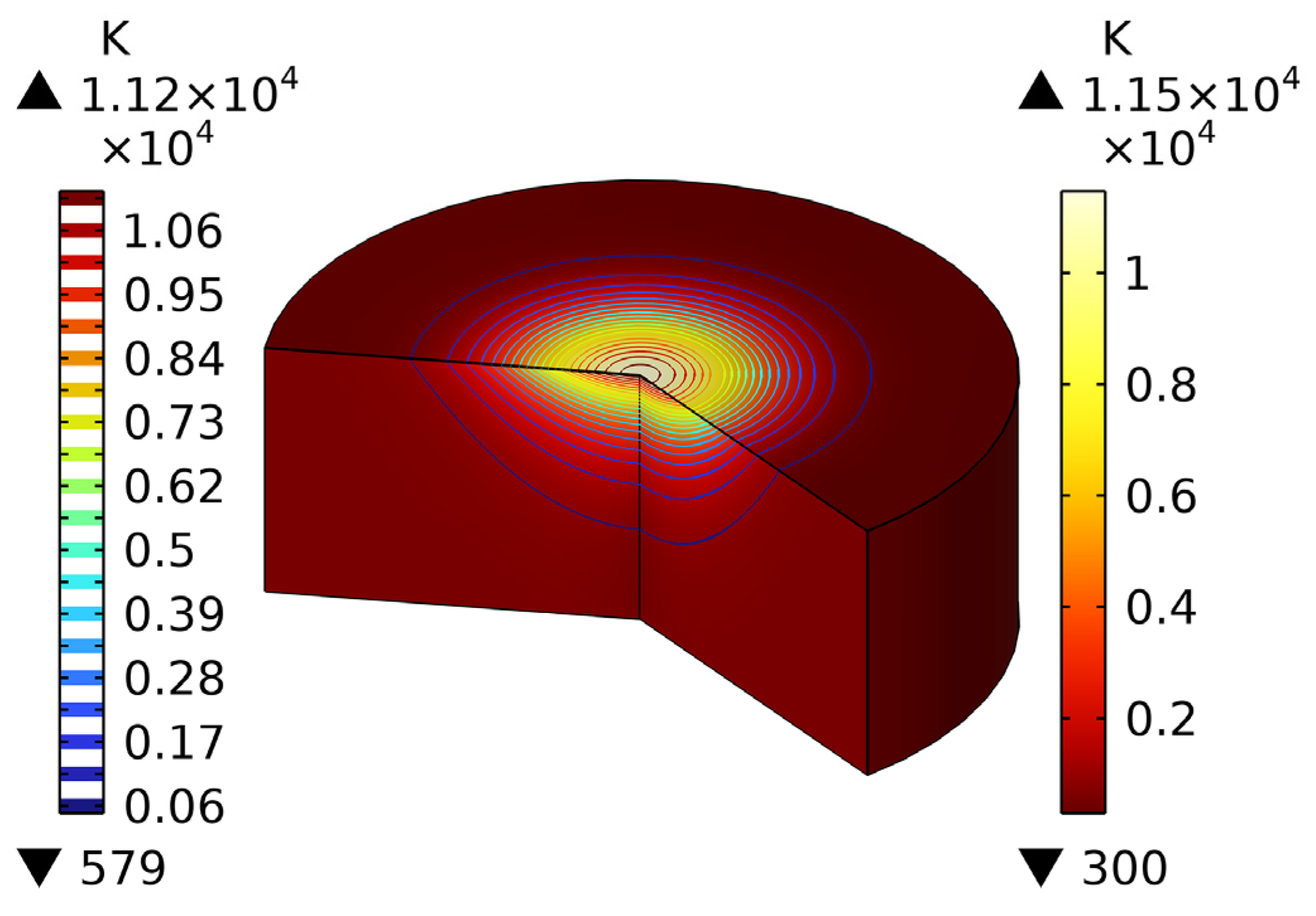

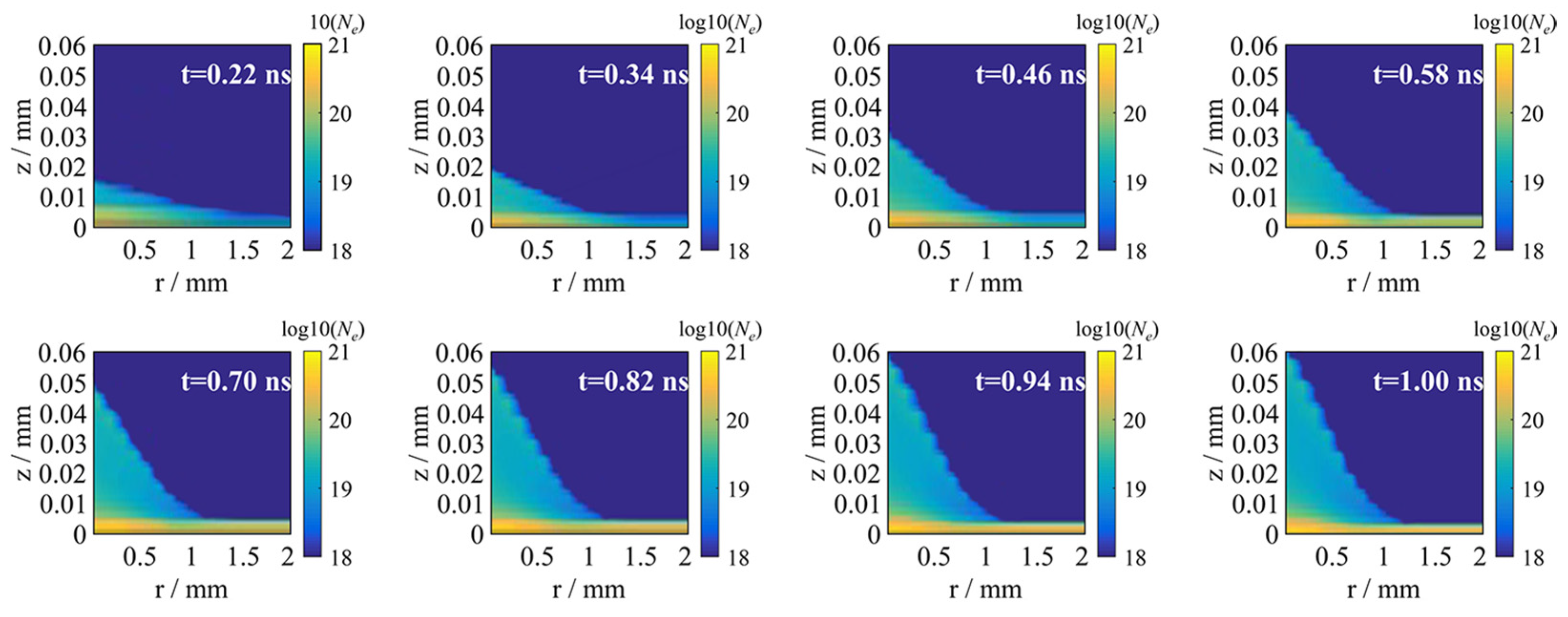
Publisher’s Note: MDPI stays neutral with regard to jurisdictional claims in published maps and institutional affiliations. |
© 2022 by the authors. Licensee MDPI, Basel, Switzerland. This article is an open access article distributed under the terms and conditions of the Creative Commons Attribution (CC BY) license (https://creativecommons.org/licenses/by/4.0/).
Share and Cite
Wang, T.; Wang, J.; Zhao, M.; Peng, H.; Zhou, J.; Qu, G.; Tan, Y.; Cai, H. Compact 15 mJ Fiber–Solid Hybrid Hundred-Picosecond Laser Source for Laser Ablation on Copper. Appl. Sci. 2022, 12, 9621. https://doi.org/10.3390/app12199621
Wang T, Wang J, Zhao M, Peng H, Zhou J, Qu G, Tan Y, Cai H. Compact 15 mJ Fiber–Solid Hybrid Hundred-Picosecond Laser Source for Laser Ablation on Copper. Applied Sciences. 2022; 12(19):9621. https://doi.org/10.3390/app12199621
Chicago/Turabian StyleWang, Tingting, Jing Wang, Meng Zhao, Hao Peng, Jianwei Zhou, Guannan Qu, Yong Tan, and Hongxing Cai. 2022. "Compact 15 mJ Fiber–Solid Hybrid Hundred-Picosecond Laser Source for Laser Ablation on Copper" Applied Sciences 12, no. 19: 9621. https://doi.org/10.3390/app12199621



